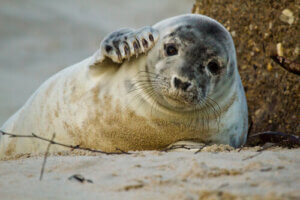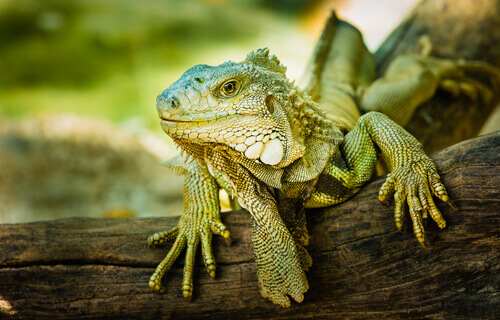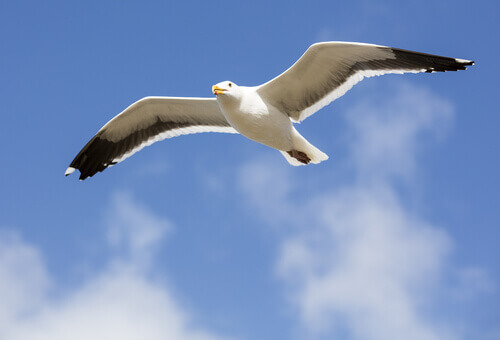Meet 5 Animals that Live on the Beach

The coastal ecosystem isn’t very abundant in terms of fauna. However, there are some species that have adapted to live between the salty water and the sand or rocks. Would you like to know some of the animals that live on the beach? Then stay with us in this article!
Examples of animals that live on the beach
A beach is a geographical feature that develops between a body of saltwater and a sand dune or rock cliff. Generally, the beach will be on a bay and will receive ‘hydration’ through the waves. The animals that live on the beach have adapted to the changing tides, winds, turbulence, and salinity of the water. Some of these animals are:
1. Seals
The phocids are a family of marine mammals that spend a lot of their lives in the water. However, they’ll rest among rocks or in the sand along the beaches. Among their main characteristics, we can point out that they don’t have an auditory canal, their legs face backward (that is why they move with their belly on land) and their fur is short. In addition, their thermal protection is provided by a large layer of subcutaneous fat.
The seal (this article’s featured photo) lives in small colonies and can form monogamous couples. They can also opt to establish a system of a dominant male and a harem of females. In addition, they feed on fish, penguins, and crustaceans. In arctic areas, they are preyed upon by polar bears and killer whales.
Some of the seal species that live on the beach are the Mediterranean, Hawaiian, and Caribbean monk seals.
2. Iguanas
The marine iguana is endemic to the Galapagos Islands and is a clear example of animals that live on the beach. They live specifically among the rocks, where they sunbathe, as they’re cold-blooded. Occasionally, they’ll move away from the sea a little, towards the mangroves.

It feeds on algae and, although it can swim, this activity is only performed by large adult males. The others wait until the tide goes out and the plants are uncovered. To get rid of the excess salt ingested, they expel ‘salt crystals’ through their nostrils.
3. Chitons
These kinds of mollusks, divided into about 600 species, are popularly known as ‘sea mealybugs’ and live along the coastline, among rocky substrates. We can also find them at great depths in colder latitudes. They remain motionless for a long time, are nocturnal, and have the ability to ‘curl up’ and form a ball when they sense any danger.

This mollusk has no eyes or tentacles, but it does have a mouth covered with teeth to feed on algae. In order to reproduce, a male and a female must come together, and the latter releases the eggs into the water. The male then fertilizes the eggs. However, in some cases, internal fertilization may also occur.
4. Gulls
Its ‘official’ name is gull, although everyone knows it as a seagull. This bird is yet another of the most representative beach-dwelling animals. It’s actually a large bird with gray, black, and white plumage and a robust orange beak (as well as orange legs and eyes).

It feeds on whatever it finds along the coastline: eggs, rats, vegetables, insects, or carrion. They hunt some of their in the air. It’s very intelligent and has a highly developed communication method and social structure. In addition, seagulls nest in densely-populated colonies and each clutch consists of up to three speckled eggs.
5. Sea turtle
Sea turtles can live in all of the world’s oceans, except the polar regions. They’re also known for their long migrations. The species that move the most from one place to another during their lifetime are the hawksbill, green, loggerhead, and leatherback turtles. Although they spend most of their time in the water, females come to beaches to spawn (males never go ashore).

Once they reproduce in the sea, the eggs take about three weeks to form inside the female’s body. After that time, the mother goes to the beach to find a suitable place to lay them. Once there, she’ll dig a large hole and lays up to 100 eggs. She’ll then cover them with sand and return to the sea.
After hatching, the newborn turtles will try to reach the water before they’re eaten by predators. Talk about survival of the fittest!
The coastal ecosystem isn’t very abundant in terms of fauna. However, there are some species that have adapted to live between the salty water and the sand or rocks. Would you like to know some of the animals that live on the beach? Then stay with us in this article!
Examples of animals that live on the beach
A beach is a geographical feature that develops between a body of saltwater and a sand dune or rock cliff. Generally, the beach will be on a bay and will receive ‘hydration’ through the waves. The animals that live on the beach have adapted to the changing tides, winds, turbulence, and salinity of the water. Some of these animals are:
1. Seals
The phocids are a family of marine mammals that spend a lot of their lives in the water. However, they’ll rest among rocks or in the sand along the beaches. Among their main characteristics, we can point out that they don’t have an auditory canal, their legs face backward (that is why they move with their belly on land) and their fur is short. In addition, their thermal protection is provided by a large layer of subcutaneous fat.
The seal (this article’s featured photo) lives in small colonies and can form monogamous couples. They can also opt to establish a system of a dominant male and a harem of females. In addition, they feed on fish, penguins, and crustaceans. In arctic areas, they are preyed upon by polar bears and killer whales.
Some of the seal species that live on the beach are the Mediterranean, Hawaiian, and Caribbean monk seals.
2. Iguanas
The marine iguana is endemic to the Galapagos Islands and is a clear example of animals that live on the beach. They live specifically among the rocks, where they sunbathe, as they’re cold-blooded. Occasionally, they’ll move away from the sea a little, towards the mangroves.

It feeds on algae and, although it can swim, this activity is only performed by large adult males. The others wait until the tide goes out and the plants are uncovered. To get rid of the excess salt ingested, they expel ‘salt crystals’ through their nostrils.
3. Chitons
These kinds of mollusks, divided into about 600 species, are popularly known as ‘sea mealybugs’ and live along the coastline, among rocky substrates. We can also find them at great depths in colder latitudes. They remain motionless for a long time, are nocturnal, and have the ability to ‘curl up’ and form a ball when they sense any danger.

This mollusk has no eyes or tentacles, but it does have a mouth covered with teeth to feed on algae. In order to reproduce, a male and a female must come together, and the latter releases the eggs into the water. The male then fertilizes the eggs. However, in some cases, internal fertilization may also occur.
4. Gulls
Its ‘official’ name is gull, although everyone knows it as a seagull. This bird is yet another of the most representative beach-dwelling animals. It’s actually a large bird with gray, black, and white plumage and a robust orange beak (as well as orange legs and eyes).

It feeds on whatever it finds along the coastline: eggs, rats, vegetables, insects, or carrion. They hunt some of their in the air. It’s very intelligent and has a highly developed communication method and social structure. In addition, seagulls nest in densely-populated colonies and each clutch consists of up to three speckled eggs.
5. Sea turtle
Sea turtles can live in all of the world’s oceans, except the polar regions. They’re also known for their long migrations. The species that move the most from one place to another during their lifetime are the hawksbill, green, loggerhead, and leatherback turtles. Although they spend most of their time in the water, females come to beaches to spawn (males never go ashore).

Once they reproduce in the sea, the eggs take about three weeks to form inside the female’s body. After that time, the mother goes to the beach to find a suitable place to lay them. Once there, she’ll dig a large hole and lays up to 100 eggs. She’ll then cover them with sand and return to the sea.
After hatching, the newborn turtles will try to reach the water before they’re eaten by predators. Talk about survival of the fittest!
All cited sources were thoroughly reviewed by our team to ensure their quality, reliability, currency, and validity. The bibliography of this article was considered reliable and of academic or scientific accuracy.
- Calderer, A. (2004) Guía de clasificación de las focas polares. Instituto de Ciencias del Mar (ICM), 1-4.
This text is provided for informational purposes only and does not replace consultation with a professional. If in doubt, consult your specialist.








